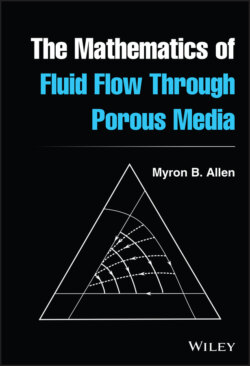Читать книгу The Mathematics of Fluid Flow Through Porous Media - Myron B. Allen III - Страница 33
2.5.4 Multiconstituent Momentum Balance
ОглавлениеThe differential momentum balance for multicomponent continua, in a form paralleling Eqs. (2.29) and (2.30), is
(2.31) (2.32)
Here, represents the rate of momentum exchange into from other constituents, excluding momentum exchanges associated purely with the transfer of mass into from other constituents. The term gives the rate of momentum exchange into attributable to mass exchange from other constituents. Equation (2.31) plays a central role in modeling fluid velocities in porous media, as discussed in Sections 3.1 and 3.2.
As with the multiconstituent mass balance equation, one can retrieve the momentum balance for a simple continuum by summing over all constituents and ignoring the distinction among them. This derivation requires a bit of tensor notation encountered again in Section 5.1.
Exercise 2.16 For any two vectors , the dyadic product is a tensor having the following action on any vector :
(2.33)
Verify that the mapping is linear.
Exercise 2.17 Recall from Section 2.2 that the matrix representation of any tensor with respect to an orthonormal basis has entries . Compute the matrix representation of .
Exercise 2.18 Sum Eq. (2.31) and use Eq. (2.32), together with the definitions of multiconstituent density and barycentric velocity , to get
where
gives the total body force per unit mass and
(2.34)
The tensor defined in Eq. (2.34) contains an anticipated part,
called the inner stress, and a contribution arising from diffusion velocities,
sometimes called the Reynolds stress, a term borrowed from the theory of turbulence.
